
The Joseph Reynolds House is a historic house at 956 Hope Street in Bristol, Rhode Island, United States, built c. 1698–1700. The three-story wood-frame house is one of the oldest buildings in Bristol and the oldest known three-story building in Rhode Island. It exhibits distinctive, well-preserved First Period features not found in other houses, despite an extensive history of adaptive alterations. It is further significant for its use by the Marquis de Lafayette as headquarters during the American Revolutionary War. It was designated a National Historic Landmark in 1983.

The Corliss–Carrington House is a National Historic Landmark house at 66 Williams Street in the College Hill neighborhood of Providence, Rhode Island. Built in 1812, it is significant as a high-quality and well-preserved example of an Adamesque-Federal style town house.
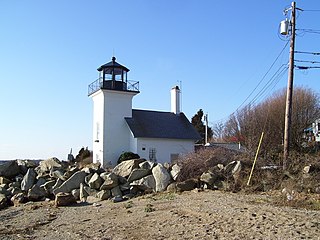
Bristol Ferry Light is a historic lighthouse in Bristol, Rhode Island, United States. It is located on the shores of Narragansett Bay at Bristol Point, the northern land point of Mount Hope Bay at the base of the Mount Hope Bridge.

The Taylor–Chase–Smythe House is a historic house on the Middletown portion of Naval Station Newport It is a two-story wood-frame structure, five bays wide, with a gable roof. A kitchen ell extends to the rear (north) of the house, and a glassed-in porch wraps around two sides of the house, ending in a porte-cochere. The house originally had a large central, chimney, but this was removed during alterations c. 1850. The house was built sometime in the second half of the 18th century by a member of the Chase family. The Chase property was acquired by the United States Navy in 1941, as part of an expansion of its facilities in Newport, and has been used since as military housing.
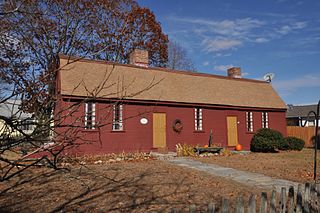
The Daniel Angell House is a historic house at 15 Dean Avenue in Johnston, Rhode Island, United States. The oldest portion of this 1+1⁄2-story wood-frame structure was built c. 1725, although it was long attributed to Daniel Angell (1744-1810). The house has an irregular front facade, seven bays wide, with two doors occupying the third and fifth bays. The western part, likely the oldest portion of the house, has a large chimney centered on five bays. The relatively unusual construction practices used in the house's construction, as well its remarkable state of preservation, make it a valuable resource in the study of Rhode Island colonial architecture.

The Israel Arnold House is an historic house on Great Road in Lincoln, Rhode Island. It is a 2+1⁄2-story wood-frame structure, set on a hillside lot on the south side of Great Road. The main block is five bays wide, with a central chimney rising through the gable roof. A 1+1⁄2-story gambrel-roofed ell extends to one side. The ell is the oldest portion of the house, built c. 1720 by someone named Olney. The main block was built c. 1760. The house was owned into the 20th century by four generations of individuals named Israel Arnold.
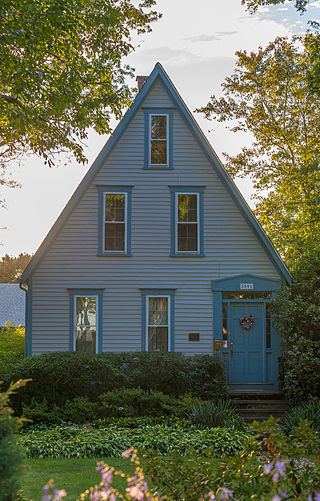
The Bicknell–Armington Lightning Splitter House is a historic house at 3591 Pawtucket Avenue in East Providence, Rhode Island. The house is of a distinctive type, a "Lightning Splitter", of which only a few instances exist in the Providence area. It is a wood-frame structure with a steep two-story gable roof. Records suggest that the house was constructed about 1827, but architectural evidence suggests it was extensively altered in the 1850s. The main entrance and the interior has a simplified Greek Revival styling. The house was listed on the National Register of Historic Places on November 28, 1980.

The Samuel B. Conant House is an historic house in Central Falls, Rhode Island. This 2+1⁄2-story structure was built in 1895 for Samuel Conant, president of a Pawtucket printing firm, and is one of the city's finest Colonial Revival houses. Its exterior is brick on the first floor and clapboard above, beneath a gambrel roof punctured by several gable dormers. The main facade has two symmetrical round bays, which rise to the roof and are topped by low balustrades. A single-story porch extends between the center points of these bays, and is also topped by a low balustrade.

The David G. Fales House is a historic house located at 476 High Street in Central Falls, Rhode Island.

The Edwin H. Farnum House is an historic house at the junction of Putnam Pike and Collins Street in Johnston, Rhode Island. It is a two-story wood-frame structure, five bays wide, with a large central chimney. It was built c. 1765, either by Stephen Angell or his son Daniel, and enlarged about 1795 by Edwin Farnum. The main entry exhibits Federal styling probably added by Farnum, with 3/4 length sidelight windows and a segmented fanlight above. The right-side bays on the first floor have been replaced by a 20th-century bay window.

The Luke Jillson House, also known as the Fisk House, is a historic house in Cumberland, Rhode Island. The wood-frame house is an excellent local example of Georgian style. Although a common date given for its construction is 1752, it was more likely built c. 1776 or in 1792, based on stylistic evidence.
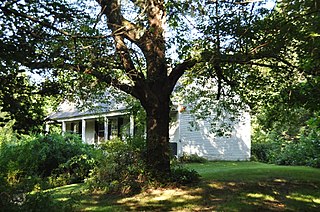
The Lewis Tower House is an historic house in Cumberland, Rhode Island.

The Stephen Allen House is an historic house on Sharp Street, on the northeast corner of its junction with Rhode Island Route 102, in West Greenwich, Rhode Island. The main block of this 1+1⁄2-story Cape style wood-frame house was built c. 1787 by Stephen Allen, a farmer. The house is five bays wide, with a central chimney and a center entry which is framed by a later Greek Revival surround. There is a 1+1⁄2-story ell extending to the east (right) of the main block. To the east of the main house stands what originally appeared to be a shed that has since been converted for use as a small horse stable. Evidence suggests this structure was built sometime before 1862 as a store.
The Blackstone Boulevard Realty Plat Historic District is a historic district roughly bounded by Blackstone Blvd., Rochambeau Ave., Holly St. and Elmgrove Ave. in Providence, Rhode Island.

The Israel B. Mason House is an historic house at 571 Broad Street in Providence, Rhode Island. It is a 2+1⁄2-story wood-frame structure, built in 1888 for Israel Bowen Mason, a wealthy merchant. It is one of the city's finest Queen Anne residences, with a visually complex assortment of projecting bays, verandas, turrets and gables. Particularly of note are its eastern porch and three-story octagonal tower. The house was designed by Stone, Carpenter & Willson, a prominent local architecture firm, for Mason, a self-made successful wholesaler of grocery and meat products. The house now houses a funeral home.

The Rathbun House is a historic house at 343 Beacon Drive in North Kingstown, Rhode Island. It is a 1+1⁄2-story wood-frame structure, five bays wide, with a large central chimney. Its exterior trim is simple and lacking in significant detailing. The interior plan is a typical five-room setup, with a narrow entry hall, two rooms on either side of the chimney, and the kitchen behind. It is one of a small number of surviving mid-18th century farmhouses in the town. It was probably one of four houses built in the area by members of the Rathbun family.

The Knight Estate is a historic estate in Warwick, Rhode Island, that is home to the Knight Campus of the Community College of Rhode Island. Developed as a country estate for a family of industrialists and later donated to the state, the main house and its outbuildings were listed on the United States National Register of Historic Places in 1984.
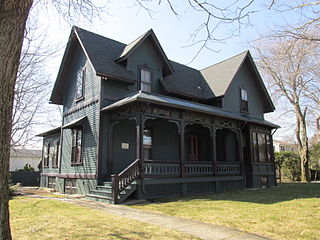
The Louis Kotzow House is a historic house in Pawtucket, Rhode Island. It is a 1+1⁄2-story wood-frame structure, laid out in an L shape. Its exterior is visually busy, with numerous projecting dormer and gable sections, and elaborate woodwork, including bracketed eaves and applied Stick style woodwork on a projecting bay section. Its porch has a delicate jigsawn railing, with a wooden frieze and decorative arches above. The house, built c. 1875, is one of two built by the German Land Cooperative Association, which sought to create a German-speaking enclave in the area.

The Esten–Bowen House is a historic house at 299 Ironmine Road in Burrillville, Rhode Island. The 1+1⁄2-story timber frame Cape style house was built c. 1790 by John Esten, a major landowner in eastern Burrillville in the second half of the 18th century. The main block is five bays wide and two deep, with a massive central chimney. A kitchen ell to the right of the main block appears to be an early addition. The house was held in the Esten family until 1879, by which time its surrounding property had been reduced to just 30 acres (12 ha). This property was acquired by Esther Bowen in 1941 and the house was rehabilitated, with modest Colonial Revival alterations. The property includes a 19th-century shed, and foundational remnants of a blacksmithy and barn.

The Susan S. and Edward J. Cutler House is a historic house in Providence, Rhode Island. It is an L-shaped 1+1⁄2-story wood-frame structure, with a gabled roof and a single-story porch and vestibule in the crook of the L. The front facade has a rectangular projecting bay, with panels below the windows, and a bracketed hip roof. The front and side gables both feature Stick style decorative woodwork. The entry porch roof is bracketed, matching the front bay, and has a jigsawn balustrade. The interior features late Victorian woodwork, plasterwork and original hardware. The house was built in 1880, probably from plans in a published pattern book, and was the first to be built in a relatively new subdivision on Providence's north side. It is a well-preserved example of a "picturesque cottage", a style popularized by a number of 19th-century architects.





















